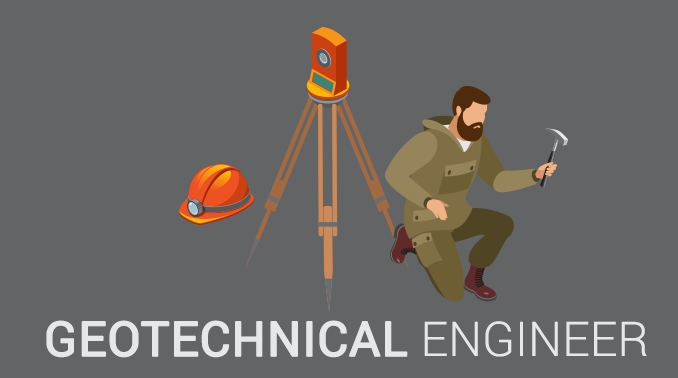The smart Trick of Geotheta That Nobody is Discussing
The smart Trick of Geotheta That Nobody is Discussing
Blog Article
Some Known Incorrect Statements About Geotheta
Table of ContentsSome Ideas on Geotheta You Should KnowNot known Details About Geotheta Geotheta Things To Know Before You BuyThe Only Guide for GeothetaGetting The Geotheta To Work

They conduct site examinations, collect examples, perform research laboratory examinations, and examine information to review the viability of the ground for building projects - Engineer of Record. Based upon their searchings for, geotechnical designers give referrals for structure layout, incline stability, preserving frameworks, and reduction of geotechnical hazards. They team up with other specialists, such as engineers, structural engineers, and building teams, to ensure that geotechnical considerations are integrated right into the total task layout and execution
By evaluating the habits and residential or commercial properties of soil and rock, they can identify potential geotechnical risks such as landslides, dirt negotiation, or incline instability. Their know-how aids avoid failures or mishaps that might endanger lives and residential or commercial property. Below are some thorough obligations and obligations of a geotechnical engineer: Site Investigation: Geotechnical engineers conduct site examinations to gather information on subsurface problems.
They translate the information to understand the homes and actions of the soil and rock, including their toughness, permeability, compaction characteristics, and groundwater conditions. Geotechnical Analysis and Style: Geotechnical designers evaluate the data collected throughout website examinations to analyze the stability and viability of the site for construction projects. They carry out geotechnical computations and modeling to review factors such as bearing ability, negotiation, incline stability, lateral earth pressures, and groundwater flow.
Everything about Geotheta
Structure Style: Geotechnical engineers play an important function in designing foundations that can safely sustain the intended framework. They examine the dirt conditions and tons needs to identify the proper structure type, such as shallow structures (e.g., footings), deep foundations (e.g (https://hub.docker.com/u/geotheta)., stacks), or specialized strategies like soil renovation. They consider elements such as negotiation limitations, bearing capability, and soil-structure communication to establish optimum foundation styles
They evaluate building and construction plans, screen site activities, and conduct area assessments to confirm that the style referrals are complied with. If unpredicted geotechnical issues arise, they analyze the circumstance and provide suggestions for remediation or changes to the style. Threat Assessment and Mitigation: Geotechnical engineers analyze geotechnical risks and dangers related to the job website, such as landslides, liquefaction, or dirt disintegration.

Collaboration and Communication: Geotechnical designers function very closely with various other experts associated with a job, such as architects, structural engineers, and building teams. Reliable interaction and partnership are vital to integrate geotechnical factors to consider into the overall job style and construction process. Geotechnical engineers provide technical know-how, response inquiries, and ensure that geotechnical demands are satisfied.
Rumored Buzz on Geotheta
Right here are some kinds of geotechnical engineers: Structure Engineer: Foundation engineers specialize in creating and analyzing foundations for structures. They assess the dirt conditions, tons needs, and website qualities to identify the most appropriate structure type and design, such as superficial structures, deep foundations, or specialized strategies like pile structures.
They evaluate the factors influencing incline security, such as soil properties, groundwater conditions, and incline geometry, and create approaches to stop incline failures and minimize risks. Quake Designer: Earthquake engineers concentrate on assessing and designing frameworks to stand up to seismic pressures. They examine the seismic hazard of a site, evaluate soil liquefaction possibility, and develop seismic style standards to guarantee the safety and security and resilience of structures throughout quakes.
They perform area testing, accumulate samples, and examine the accumulated data to define the soil residential properties, geologic developments, and groundwater conditions at a site. Geotechnical Instrumentation Designer: Geotechnical instrumentation engineers concentrate on tracking and determining the behavior of dirt, rock, and structures. They set up and keep instrumentation systems that check elements such as soil negotiation, groundwater degrees, slope movements, and structural variations to analyze efficiency and offer very early cautions of possible issues.
Getting My Geotheta To Work
They carry out examinations such as triaxial tests, combination examinations, straight shear tests, and leaks in the structure tests to collect information for geotechnical evaluation and design. Geosynthetics Engineer: Geosynthetics engineers focus on the layout and application of geosynthetic products, such as geotextiles, geogrids, and geomembranes. They use these materials to enhance dirt security, enhance slopes, check my blog offer water drainage solutions, and control erosion.
They have a tendency to be investigatory people, which suggests they're intellectual, reflective, and inquisitive. They are interested, systematic, sensible, logical, and rational. Some of them are likewise social, suggesting they're kind, charitable, participating, person, caring, practical, compassionate, sensible, and friendly - Geo Tech Engineering.
In the workplace setting, geotechnical designers use specialized software application devices to execute estimations, produce designs, and examine data. They prepare records, testimonial job specs, interact with customers and group participants, and coordinate project activities. The workplace setup provides a favorable setting for research study, evaluation, and collaboration with other specialists included in the project.
All about Geotheta
They frequently check out job websites to conduct site investigations, assess geotechnical problems, and collect information for evaluation. These gos to involve traveling to different areas, in some cases in remote or challenging terrains. Geotechnical designers may do soil tasting, conduct examinations, and screen construction activities to guarantee that the geotechnical elements of the project are being carried out correctly.
Geotechnical engineers likewise function in specialized geotechnical labs. In these facilities, they carry out experiments, perform examinations on dirt and rock examples, and evaluate the design properties of the materials. Geotechnical research laboratory designers work thoroughly in these environments, taking care of screening equipment, running tools, and taping data. They work together with various other research laboratory staff to guarantee exact and reputable screening results.
Report this page